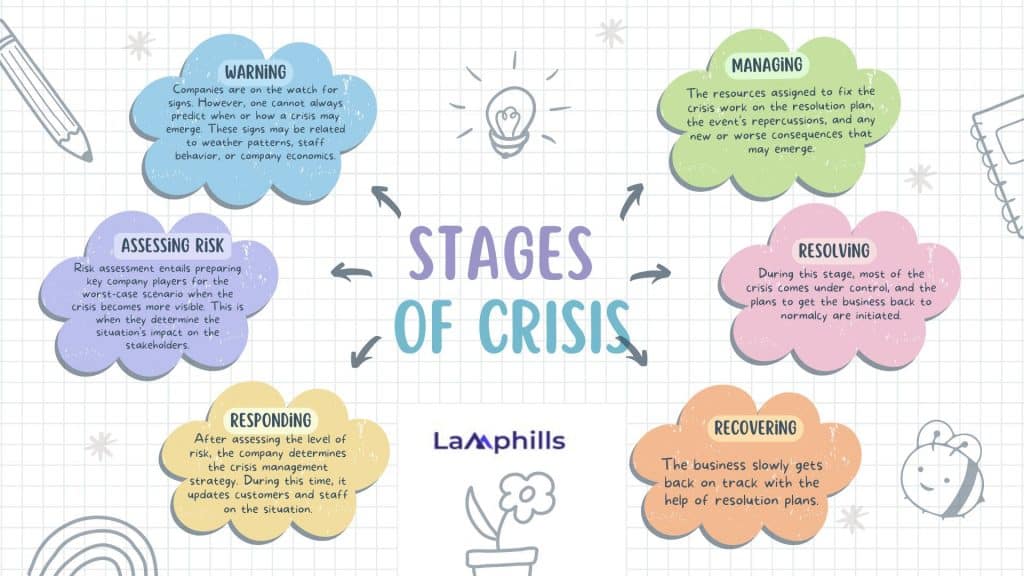Crises are unavoidable in the world of business. Whether you run a small business or manage a global corporation, the possibility of a crisis always exists. Understanding the various types of crises and how to handle them effectively is essential for every organization. This blog article will look at the various types of crisis, particularly in the context of public relations (PR), and offer tips for dealing with them. By the end of the day, you’ll understand what a public relations crisis is, the various types, their causes, warning signs, and tactics for dealing with them.
Key Takeaways
- Crises are inevitable in business. No organization is immune to crises, whether financial, technological, or reputational. Being prepared to deal with these situations properly is critical for preserving stability and reputation.
- Understanding crisis types is crucial. Financial, technological, personnel, and natural crises have distinct causes and consequences. Recognizing these types enables firms to adapt their crisis management tactics.
- Having a well-defined crisis management strategy is essential. This plan should include communication techniques, roles and duties, and contingency plans for different crisis situations.
- Open and transparent communication with all stakeholders (workers, customers, investors, and the media) is crucial during a crisis. This includes communicating clearly and concisely through press releases, media relations, and public apologies.
- Organizations that are prepared to handle crises can minimize damage and recover more effectively. This includes having a designated crisis communication team and ensuring everyone understands their roles and responsibilities.
What is a Crisis in Public Relations?
A crisis in public relations refers to any occurrence or scenario that threatens an organization’s reputation, credibility, or stability. Internal issues, such as management mistakes, can trigger a crisis, and external events, such as natural disasters or economic downturns. In public relations, a crisis can quickly grow if not handled appropriately, resulting in long-term damage to an organization’s reputation.
According to the Public Relations Society of America (PRSA), crises are unpredictable events that, if not handled properly, can harm an organization’s operations, reputation, and financial status. Public relations specialists must be ready to act swiftly and efficiently to minimize damage.
I remember working with a company that had a product recall. The scenario was heated because the company’s reputation was on the line. It was a typical PR crisis in which timely and effective communication was crucial for minimizing the negative effects.
Types of Crisis in Public Relations
There are various types of crisis in Public relations.. This includes:
#1. Financial Crisis
A financial crisis occurs when an organization unexpectedly loses a considerable sum of money, making it difficult to satisfy financial obligations or service debts. A financial crisis occurs when a firm unexpectedly loses three key clients that account for 45% of its revenue. Also, a financial crisis can be caused by several factors, including:
- Loss of revenue
- Inflation
- Bankruptcy
- Loss of market
- Sudden change in market trends
A financial crisis might impede an organization’s capacity to serve customers successfully. This type of occurrence also increases the danger of talent turnover, therefore being proactive in crisis management is critical to preventing corporate destabilization.
A financial crisis can also result in a loss of investor confidence, exacerbating the situation. Companies must communicate honestly with stakeholders about the efforts they are taking to stabilize finances and recover from the crisis.
I worked for a company that lost a large chunk of its market value overnight, during the 2008 financial crisis. The threat was apparent, and a clear communication plan was vital to reassuring stakeholders and avoiding more damage.
#2. Technological Crisis
This type of crisis might occur if your organization’s technological resources break down unexpectedly. This could involve hardware and software problems, as well as industrial accidents. For example, a company that sells products or services through a website or online store can quickly lose tens of thousands of dollars in income if its servers fail unexpectedly. If your competition starts producing their products using technology that allows them to minimize production costs and launch faster, they will swiftly grow their market share and reduce your revenue.
The 2017 Equifax data breach is a classic example of a technological crisis that caused significant reputational damage. The corporation faced lawsuits, governmental regulations, and a major loss in customer trust. In such circumstances, effective crisis management includes taking immediate action to rectify the breach, communicating openly with the public, and implementing measures to prevent future incidents.
#3. Personnel Crisis
A personnel crisis occurs when someone in your business engages in illegal or unethical action that harms your company’s public reputation. The issue could be related to the employee’s behavior at work or in their personal life. The way the organization handles the matter is crucial as it can help them retain a more good public image. For example, a workplace dispute or an insensitive comment made by a senior executive may result in negative publicity for your organization.
When your organization experiences a crisis as a result of an employee’s behavior, it is critical to propose a balanced plan that addresses the issue immediately. Determine the appropriate disciplinary actions to take against the individual, both to preserve their legal rights and protect the reputation of your business.
#4. Natural Crisis
A natural crisis happens when events such as earthquakes, tornadoes, tsunamis, or hurricanes affect a business’s operations. While most firms can recover rapidly from natural disasters, some, particularly those in the extractive and power industries, may suffer significant losses. For example, if a tsunami triggered explosions at its nuclear power plants and destroyed hundreds of miles of electrical lines, a power company may find it difficult to resume operations.
During the COVID-19 outbreak, several organizations, including one where I worked, had to immediately transition to remote operations. The situation demonstrated the value of having a disaster recovery and business continuity plan in place.
Companies must be proactive in their crisis management techniques while dealing with natural crises. This involves establishing contingency preparations, good communication with employees and customers, and taking every possible step to support the affected communities.
#5. Organizational Crisis
There are three fundamental types of organizational crisis, including:
- Crisis of deception: A deception crisis happens when an employee of a firm misrepresents information about the organization, causing damage to its reputation and misleading others. Taking legal and disciplinary action against the employee is a good technique for dealing with this situation.
- Crisis of management misconduct: A crisis of management misconduct arises when management engages in unethical behavior, such as selling counterfeit products, selling customers’ sensitive information, or engaging in unlawful activity.
- A crisis of skewed management values: A crisis of skewed management values occurs when management makes a move that benefits the firm in the short term without considering the long-term implications, putting investors’ money at risk. Management may conceal facts regarding investments or abuse their power to achieve their aims.
Organizational crises can result in lawsuits, reputational damage, and a loss of loyalty. Managing organizational crises typically entails developing a new business culture with a new set of principles that drive management and employee behavior, assuring ethical behavior while the company serves consumers and creates income.
#6. Confrontational Crisis
A confrontational crisis happens when an individual or group of individuals makes explicit demands on management and takes action to ensure that their requirements are met. Confrontational crises can result in strikes, boycotts, and workplace blockages. Negotiation is one of the most effective strategies to handle confrontational issues, particularly with the assistance of a professional negotiator.
#7. Crisis of Malice
Malice crises are caused by unhealthy rivalry or competition. For example, a rival corporation may start a smear campaign against a prominent leader or even a product line in order to undermine a more successful competitor and lose public trust and market share. Another example is when people write unfavorable reviews about a company or spread rumors about its products or services to damage customer confidence.
To prevent competitors from damaging your company’s reputation, you must take legal action, use skilled public relations skills, and create professional customer relationships.
#8. Human-Made Disasters
A human-made disaster is a crisis created by people’s actions. For example, a cyberattack might impair a company’s activities and make them difficult to restore. Financial crises, such as those caused by high-level market manipulation and transportation mishaps, can also cause major problems for a business. If your company is subject to human-made disasters, you must have an action plan in place to safeguard yourself and your staff.
Signs of a PR Crisis
Recognizing early warning signs is the first step in addressing a public relations crisis.
Some early signs are more noticeable than others. Negative media coverage and viral social media activity are rather straightforward to identify. Irregularities in a company’s finances may go unreported until an audit is performed, hence an audit might be viewed as an early warning sign.
Faulty products are another early warning indication. Examples include incorrectly stocked goods in a supermarket or a production fault at a factory that disrupts a day’s worth of productivity.
Other warning signs could include impending bad weather, such as a storm that would damage critical infrastructure and create an oil spill or other disaster. Employee behavior might also provide an early warning of future public relations concerns.
Stages of Crisis
Before deciding on a crisis management strategy, it is critical to understand the stages of the crisis. See infographics below:

Types of Crisis Management Strategies in PR
A firm should endeavor to work through a crisis and take the appropriate actions. The following are some common crisis management procedures.
#1. Responsive Crisis Management
A crisis cannot be handled without having a plan of action in place for the current scenario. In responsive crisis management, specialists carry out the strategy while dealing with any unanticipated challenges that might arise. This type of management is used to deal with people and financial issues in which a prompt response is critical. Companies may develop a plan to notify all stakeholders or implement crisis management solutions.
#2. Proactive Crisis Management
When a company predicts a possible disaster and has strategies in place to prevent or confront it, it is considered proactive. Though it is true that trying to prevent or plan ahead of a situation is not possible at all times, monitoring threats to the organization can help it assess the impact of a prospective crisis. For example, organizations with offices in earthquake-prone areas have shock-resistant structures and train their staff by discussing an evacuation plan.
#3. Recovery Crisis Management
Companies may fail to anticipate a crisis and only become aware of it when it is too late. Personnel and technological crises can occasionally catch a firm off guard, resulting in long-term negative consequences. The corporation can salvage what remains of the situation. It can issue a public apology and investigate what caused the unforeseen issues.
No firm expects a PR crisis, but it must be prepared to face one. Businesses can insulate themselves from a negative reputation and move on by knowing the many types of crisis, phases, and crisis management techniques.
Managing Crisis Types in Public Relations
Here are a few tips on managing crisis types in public relations:
#1. Create a Crisis Management Plan
A crisis management plan is a thorough document that details how an organization will respond to a crisis. It contains communication methods, roles and responsibilities, and backup plans. In my experience, having a well-defined crisis management plan was quite helpful in managing the product recall. The strategy offered a clear path for the team, ensuring that everyone understood their position and the next steps to follow.
#2. Communication
Crisis management relies heavily on effective communication. Organizations must communicate openly with all stakeholders, including employees, customers, investors, and the media.
#3. Post-crisis Evaluation
Following a crisis, it is critical to undertake a post-crisis evaluation to examine what went wrong, what was done successfully, and what might need to be improved. This allows businesses to learn from the crisis and plan better for future crises.
A post-crisis evaluation should include all relevant players and an extensive review of crisis management initiatives. This enables firms to discover areas for development and boost their crisis management methods.
The Role of Crisis Communications in PR
PR is really about communication. In non-crisis situations, this typically results in positive two-way communication between an organization and its audience. Communication is especially vital while dealing with a crisis. Getting the tone, language, and goals of this communication right is critical to crisis management success.
A well-crafted crisis communications plan may include news releases, media relations, public apologies, or clarification of the changes the impacted organization is implementing in response to the problem.
What is Crisis Communication?
Crisis communication refers to the different tools, techniques, and protocols used by an organization to communicate in the face of a threat to its reputation and public perception.
As with almost every other component of crisis management, managing a public relations crisis is considerably easier when the organization and PR crisis team are well-prepared and have a communication strategy ready to implement.
Preparing ahead of time entails ensuring that important personnel can successfully communicate with one another during times of crisis. To guarantee that the business can respond quickly and effectively, all necessary information must be available and shareable among key staff via dependable communication channels.
A crisis can strike at any time. Don’t be caught off guard. Our free Crisis Communication Plan Template will help you develop a robust strategy to protect your organization’s reputation. Download now and safeguard your future.
What are the 4 Ps of crisis?
The 4 Ps of crisis management are:
- Prediction
- Prevention
- Preparation
- Performance
What are the three main types of crises?
The three main types of crises are:
- Product or service crises
- Reputational crises
- Personnel crises
What are the four stages of a crisis public relations?
The four stages of a crisis in public relations are:
- Pre-crisis
- Crisis
- Recovery
- Post-crisis evaluation
What are the 5 Cs of crisis management?
The 5 Cs of crisis management are:
- Contingency
- Communication
- Coordination
- Control
- Closure
Conclusion
Understanding the many types of crisis and how to handle them effectively is critical for every organization. Being prepared might be the difference between a tolerable issue and a disaster, whether it’s a financial, technological, or reputational crisis,.
Crises are unavoidable. The goal is not to avoid them but to be prepared to deal with them successfully when they arise. So, how prepared is your organization to deal with a crisis? Have you identified the potential types of crisis that might affect your business? Share your thoughts and experiences with me in the comment section.
Related Articles
- How to Deal With Social Media Crisis Like a Pro: Best Strategies
- Turning Crisis to Opportunity: How I Help Brands Handle Negative PR Effectively
- The Best 15 Crisis Management Companies You Need Right Now 2024
- CRISIS COMMUNICATION: Definition and Best Strategies
- Brand Crisis Management: 7 Tested Tips






